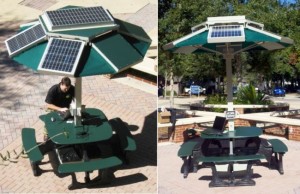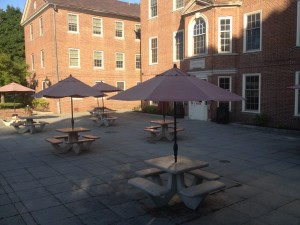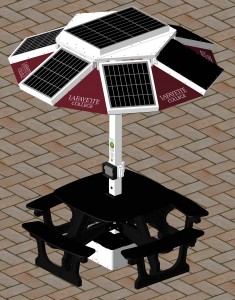Introduction
Austin Davis, Austin Luginbuhl, Morgan Grasz, and Colleen Way, with assistance from Professor Benjamin Cohen, developed the idea for this Engineering Studies capstone project. The specifications were fairly general; groups were to create and execute a project, which could reasonably be completed within the last half of the Fall semester. Our group chose to pursue campus sustainability. The planning process, including social context, economic, technical, and political analysis, is detailed in the following pages. The conclusion section explains the outcome of the project, and what follow-up should be completed for the project in the future. Please find a pdf version of this full web-based report here.
What does it take to install umbrella-style solar charging stations on campus? What kind of demo could illustrate this?
As a higher education institution, it is important for Lafayette College to inform its students of contemporary global issues, such as climate change. The College has demonstrated a lack of commitment to an important aspect of this education, by failing to move forward with proposed initiatives, perhaps due to a heavily bureaucratic administrative system as well as economic restraints. For instance, several Engineering Studies capstone groups have attempted to impose a more efficient recycling system on campus in the past, to no avail. Some initiatives that have been implemented have proven to be unsuccessful, due to their lack of accessibility or relevance to students. One such initiative was a electric car charging area in the Sullivan Parking Lot. Few students at Lafayette drive electric cars, so many were unable to take advantage of this resource. In order to successfully implement a sustainable initiative on campus, it is important to consider social context, and economic, technical, and political feasibility.

After thorough analysis in the aforementioned categories, we found the implementation of the Solar Power-Dok, created by EnerFusion, Inc., at one of our outdoor eating facilities to be a feasible option for Lafayette College. As defined on the company’s website, the Solar Power-Dok is “designed to provide self-sustaining green energy wherever it is placed outdoors with access to direct sunlight.” The technology is comprised of a table and umbrella, which is attached to solar panels. This picnic table is a charging station, and would most likely be implemented at Gilbert’s Café, due to high traffic and access to direct sunlight.

Some potential challenges we may face with this project include lack of student awareness, cost of implementation, the usefulness of this technology on Lafayette’s campus, and administrative acceptance. In order to overcome these challenges, it is important to partner with well-established campus organizations, foster relationships with the manufacturer, model the impact of the solution on campus, and maintain efficient communication.

In order to lower the cost of implementation, we asked the representative from EnerFusion if we could purchase just the umbrella, rather than the umbrella attached to the picnic table. We already have similar picnic tables in front of Gilbert’s, and it could have potentially lowered the initial cost of the project. We discovered, however, that the batteries are not compatible to the tables we currently have, so we must purchase the entire table system. The Solar Power-Dok picnic tables themselves are environmentally friendly; they are made out of recycled plastics.
Another challenge we may face is students’ willingness to utilize the charging station. As previously mentioned, projects that have been implemented in the past have proven to be either too complicated, or irrelevant to students. We believe, however, that the location, and ease at which students can use the Solar Power-Dok, will address this issue. In order to gauge students’ interest in the project, we sat in the Farinon College Center and asked students to sign a petition for the implementation of the solar-powered charging station. We collected approximately 200 signatures, which represents almost 10% of the student body. Therefore, we believe that this project will be widely accepted and used by Lafayette students.
The final hurdle we will most likely need to overcome is Lafayette administration’s acceptance of this proposal. If we do make this purchase, it would be a rather large investment for the College. We can justify this cost, however, by explaining the several benefits that are associated with the table. It will raise awareness among not only the current student body, but also prospective students, about the College’s efforts towards sustainability. In addition, we have presented our ideas in an organized, understandable, and professional manner, so that our proposal is taken into serious consideration. We have also involved members of the Engineering Faculty, such as Professor David Veshosky, who are willing to offer their support for this proposal.
The success of this project relies on thorough planning. In the following sections, we will discuss the social context, and the policy, technical, and economical analysis to be applied for the implementation of the Solar Power-Dok.
Social context is an important aspect of the planning process, because it is important to understand the society in which the technology will be implemented, in order to ensure the highest rate of success. Lafayette College is a unique community, and it is therefore crucial that we take all characteristics (e.g. students’ interest, awareness, etc.) into consideration with the planning of our project.

Continue to the analysis of America’s and Lafayette College’s social context.

Leave a Reply